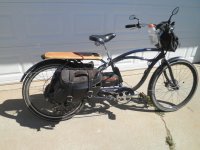spectastic
1 mW
- Joined
- Jul 24, 2017
- Messages
- 18
I originally wanted to build an electric motorcycle for commutes, errand runs, or just joy rides around the beautiful hill country around here. However, motorcycles are heavy, and consume around 116 Wh/mile on average, which is like a best case scenario of a zero motorcycle. On the other hand, electric bikes have much lower rolling resistance, narrower profile, potentially higher power/weight (mostly due to less weight) compared to motorcycles, which I assume is the reason why a commonly quoted figure is around 20 Wh/mile, for standard rear hub motor.
So the bike I have in mind can put out 2000-4000 watts that can get me to 35-50 mph, with a 2.5 kWh battery that can get me 100+ miles if I go gentle, and maybe 70 miles if I crank it up, which is totally fine.
I've browsed around a little bit, and saw that the vector bikes have exactly what I'm looking for, except they have a $6,500 price tag, which is actually a pretty good deal, but I'm a grad student.. Aside from the financial incentive of building my own setup, I would also like to sort of customize the bike to my own liking. However, I also realize that this may be a losers game. Sourcing the motor, BMS, controller, battery pack, custom rack to hold everything, all separately may very well end up costing more than a stock setup.
this is where I'm seeking guidance and advice from the knowledgeable people here. Can I build a 2000-4000W electric bike with a 2.5 kWh battery for ~$3000?
PS. I saw some youtube videos of a guy recycling a whole bunch of old laptop batteries spot welded together to make his battery pack, and got it done for pennies on the dollar. I realize that the battery is where most of the cost is going to come from, so as long as we can cut that down somehow, it should be manageable, right?
So the bike I have in mind can put out 2000-4000 watts that can get me to 35-50 mph, with a 2.5 kWh battery that can get me 100+ miles if I go gentle, and maybe 70 miles if I crank it up, which is totally fine.
I've browsed around a little bit, and saw that the vector bikes have exactly what I'm looking for, except they have a $6,500 price tag, which is actually a pretty good deal, but I'm a grad student.. Aside from the financial incentive of building my own setup, I would also like to sort of customize the bike to my own liking. However, I also realize that this may be a losers game. Sourcing the motor, BMS, controller, battery pack, custom rack to hold everything, all separately may very well end up costing more than a stock setup.
this is where I'm seeking guidance and advice from the knowledgeable people here. Can I build a 2000-4000W electric bike with a 2.5 kWh battery for ~$3000?
PS. I saw some youtube videos of a guy recycling a whole bunch of old laptop batteries spot welded together to make his battery pack, and got it done for pennies on the dollar. I realize that the battery is where most of the cost is going to come from, so as long as we can cut that down somehow, it should be manageable, right?


